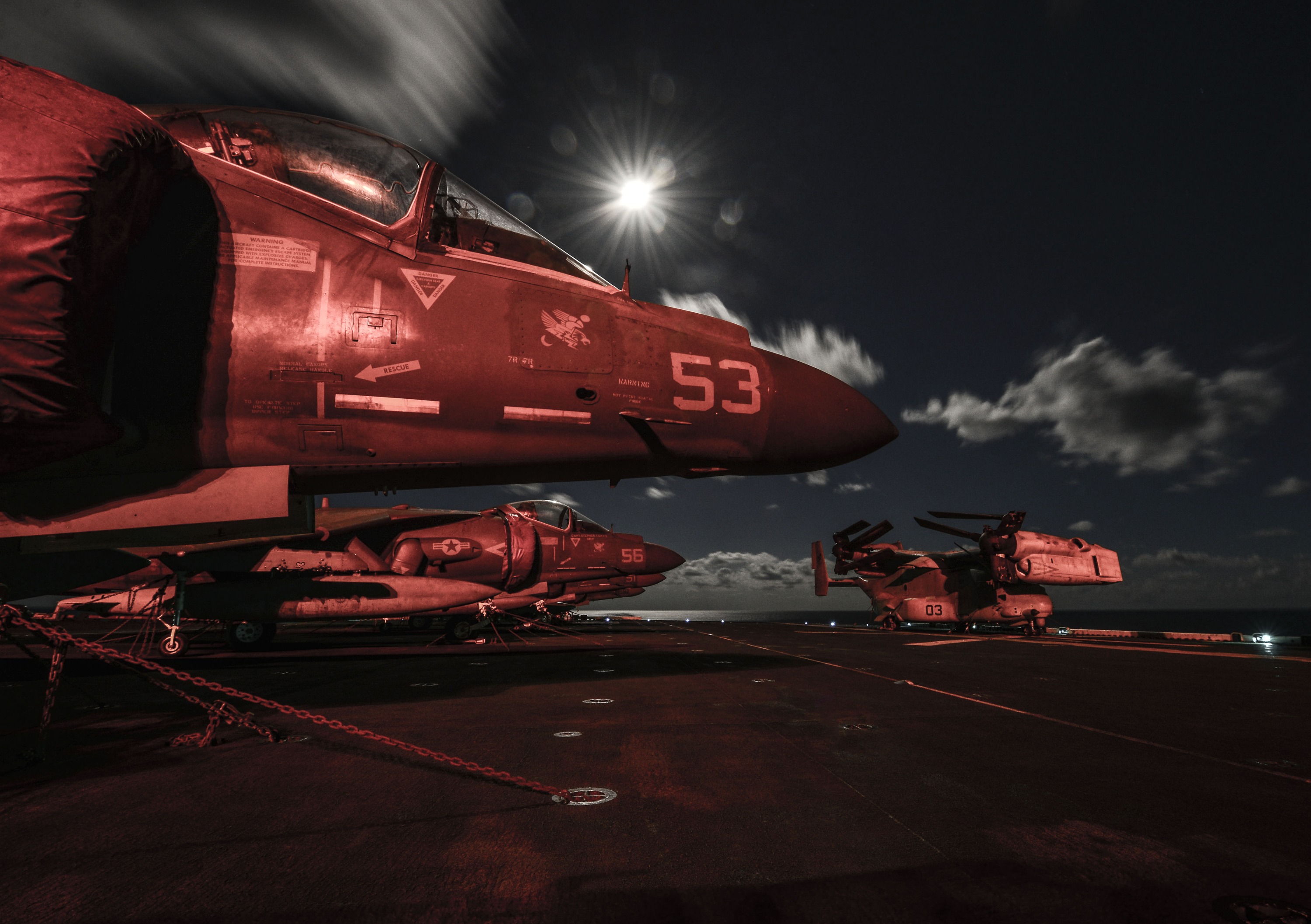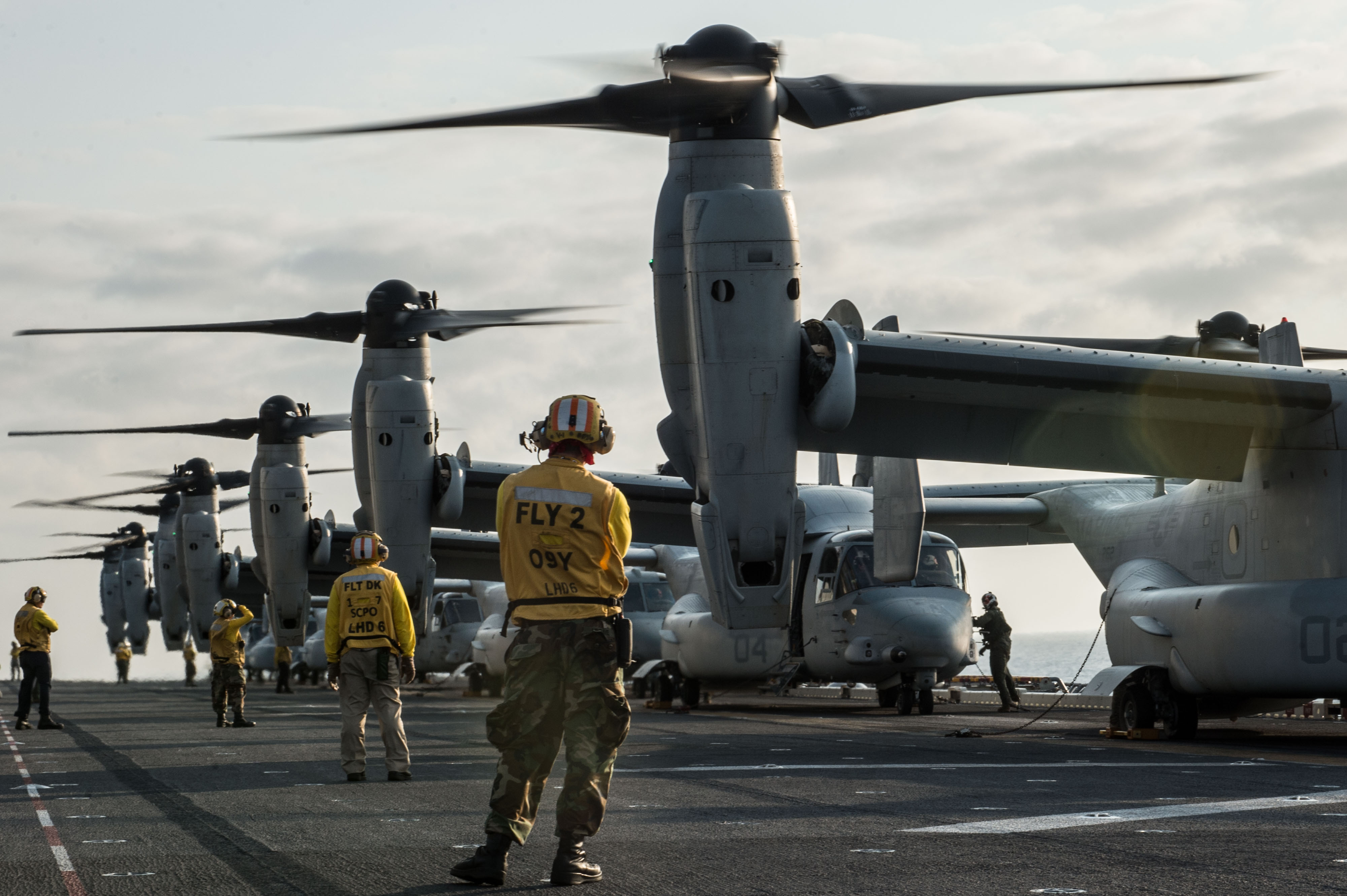
PENTAGON — The Navy and Marine Corps should explore ways to make Marine aircraft a more useful part of the naval battle force – using alternate mixes of aircraft types on amphibious ship flight decks, finding additional missions for those aircraft, and pursuing increased connectivity to the rest of the naval fleet, the deputy commandant for aviation told USNI News.
In recent memory, the aviation combat element (ACE) in the Marine Expeditionary Unit (MEU) has served to support the MEU’s ground combat element. The ACE brought Marines and their weapons ashore in combat situations and helped bring materiel ashore in humanitarian assistance missions.
But Lt. Gen. Jon Davis argues the MEU, and particularly the ACE – which already includes the game-changing MV-22 Osprey and will soon include the equally transformative F-35B Joint Strike Fighter – can and should do more.
“We have the finest aircraft carriers in the world, we have the finest submarines in the world, we have the finest amphibious ships – we might need those amphibious ships to be doing something a little bit different than we’ve asked of them in the past to be value-added to the subs and the cruisers and the carriers, to be more value-added episodically before we reconfigure to the traditional mission and force contribution you expect an amphibious ship to be able to do,” Davis said in a Nov. 16 sit-down interview in his office.
“At the end of the day, we need them to power project Marine ground forces, a MAGTF (Marine Air-Ground Task Force), ashore, and they need to be able to do that. But is there more that we can get out of those ships, and what do we have to do to those ships to get more out of them?”
First, Davis argued, the Marines need to rethink what should constitute the ACE onboard amphibious ships.
“You in your brain, and all of us in our brains, have, this is a MEU: six Harriers or six F-35s, 12 V-22s, three or four CH-53s, seven skids [light attack helicopters], some VMU [Marine Unmanned Aerial Vehicle Squadrons],” Davis said.
But what if that combination, which includes a little bit of everything, means that the ACE is not optimized for anything?
“There are many scenarios where we would want to have the L-class carrier loaded with F-35Bs – the full squadron, 16 airplanes or more, plus four to six V-22s with a tanker package,” Davis said.
“And that could maybe be the way our ships sail for a contingency, or sail as a matter of principle in the future as we are part of a naval formation to go do Phase 0, Phase 1 strike operations. Augment the carrier strike group’s ability to project power with fifth-generation capabilities until that time when we don’t need the augment from the L-class carriers, and then you would flow ashore – because now we have long-range assault support assets, V-22s, 53s, that can air-refuel. You fly them from their bases to that L-class ship, and now it turns into its normal MEU.”
“And then maybe you have something like a [Operation] Sea Angel, some kind of humanitarian disaster that doesn’t need jet aircraft – you can fly all the jet aircraft off and load up that amphibious carrier with heavy-lift helicopters and V-22s,” Davis continued.
“So to me, the gator, the amphibious ship, the amphibious carrier, can be what you need that ship to be. And I think we as a naval force need to embrace that and understand that, experiment with that, test that and employ all the capabilities we have in a much more innovative way than we have in the past.”

Davis said he would not be surprised if combatant commanders started asking for these kinds of tailored aviation packages, and the Navy and Marine Corps need to be ready to respond. He said thinkers at Marine Corps Base Quantico and at the war colleges should begin writing papers and discussing new doctrine, which could lead to simulations and eventually to exercises showing how a more flexible ACE could respond to everything from the “humanitarian fight” to the “90th percentile fight.”
Key in enabling the Marines to rearrange the ACE while the MEU is out at sea would be embracing the fact that Marines and their aircraft can operate from the sea base or from an expeditionary base ashore, and that platforms shouldn’t be tethered to one or the other.
Today, some aircraft belong to MEUs at sea, some belong to land-based Special Purpose MAGTFs located in Europe and the Middle East, and some are forwarded stationed ashore in places like Japan. But back in World War II, Davis said, planes seamlessly went from being carrier-based to expeditionary airstrip-based as needed.
“That we have platforms that we can project power from a sea base and an expeditionary base ashore is an amazing source of strength for the naval forces, and I think we need to understand that more fully, like our predecessors did in World War II and Korea,” he said.
“So instead of pushing back on that or fearing that, I think we need to understand how we execute and deliver combat power from sea bases and expeditionary bases ashore as part of a naval campaign.”
Davis also argues that Marine Corps aircraft should be considered when planning missions that typically would not involve amphibious forces. Particularly in the next couple years, using Marine Corps F-35Bs to supplement high-end naval fights could be important because, whereas the Marines have already declared initial operational capability (IOC) on their fifth-generation fighter, the Navy will not declare IOC on its carrier-based F-35C until 2018 or later. Davis said the Navy should consider including the F-35B in more types of missions that typically would not include the Marine Corps.
“We’re at a point in the naval forces where we need the combat power at sea that the Marine forces are going to provide from an [expeditionary strike group] in multiple scenarios,” Davis said.
“We need to be very focused on how we can be the very best partners in a big fight. How we can look at being viewed as value-added and essential to the naval campaign – not just from an amphibious assault, that’s part of it, you’ve got the potential to do that, but it could be the first part, the shaping fight.”
One roadblock Davis sees to increasing the use of Marine aviation is command and control. Whereas the Navy’s carrier strike group can communicate amongst itself and with other assets in the fleet through Link-16, Davis said zero of the Marines’ aircraft deployed today have Link-16. Efforts are underway to put Link-16 on the Harriers and Ospreys, and the F-35B is already linked in, but Davis argued that the Marine Corps helicopters ought to be brought into the network too.
“That to me is a delta, a gap that we as a naval force need to close,” he said.
“I think we need to take a look at whatever we’re doing to the carrier and look at the gator fleet, make sure that we can plug and play and share information, you don’t have anybody that’s at a disadvantage out there in a high-end fight. Because I think the F-35s and the V-22s are going to be enablers for the naval formation. So if you want them to be enablers, you have to make sure they’re fully plugged in to the command and control and the intel networks.”
Though changing the construct of the MEU ACE, networking those aircraft and incorporating them into Navy battle doctrine will take time and effort, Davis argued that doing so is an inherent part of the Marine Corps ethos.
Today’s Marine Corps aviation should “be a different kind of capability for our nation than we’ve been in the past. More. The Marines are always looking to do whatever we need to do, and this is one of those things to do whatever we need to do to go defend our freedom.”





